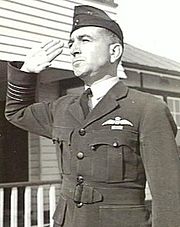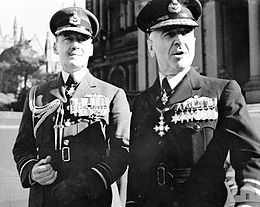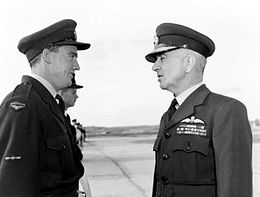John McCauley
Sir John McCauley | |
|---|---|
 Air Vice Marshal McCauley as AOC Eastern Area, 1953 | |
| Nickname(s) | "Black Jack"; "Crasher" |
| Born | 18 March 1899 Sydney |
| Died | 3 February 1989 (aged 89) Sydney |
| Allegiance | Australia |
| Service/ | |
| Years of service | 1916–57 |
| Rank | Air Marshal |
| Unit |
|
| Commands held |
|
| Battles/wars | World War II
|
| Awards |
|
| Other work | Air Force Association Federal President (1964–74) |
Following the end of hostilities, McCauley again became Deputy Chief of the Air Staff. In 1947 he was promoted to
Early career

Born in Sydney on 18 March 1899, McCauley went to school at St Joseph's College, Hunters Hill, before entering the Royal Military College, Duntroon, in 1916. He graduated as a lieutenant in 1919, and spent the next four years in staff positions with the Permanent Military Forces, including a posting to Britain.[1][2] In January 1924, he transferred to the Royal Australian Air Force as a flying officer, undertaking the pilots' course at RAAF Point Cook, Victoria.[3][4] He was nicknamed "Black Jack" in tribute to his dark looks, but a "shaky reputation" as an aviator also earned him the epithet "Crasher".[5][6] On 10 November 1925, he married Murielle Burke; the couple had a son and two daughters.[7] By 1926, McCauley was back in Britain, studying at the Royal Naval College, Greenwich, and the RAF Armament and Gunnery School. He returned to Australia in 1928, and was assigned to the staff of RAAF Headquarters, Melbourne.[1][2]
Promoted to
World War II

McCauley's seniority and instructional experience kept him in Australia on training assignments for the first eighteen months of World War II. From March to October 1940, he served as the inaugural commander of No. 1 Engineering School at
During the

After his return to Australia late in February 1942, McCauley briefly served as Senior Air Staff Officer at
Completing his term as DCAS, McCauley was posted to the
Post-war career

Among a small coterie of wartime RAAF commanders earmarked for further senior roles, McCauley retained his rank of air commodore following the cessation of hostilities.
In January 1952, Air Marshal Jones was succeeded by Air Marshal Sir Donald Hardman of the Royal Air Force. The decision by Prime Minister Robert Menzies to appoint a British officer as CAS caused controversy in Australia, compounded by his stated reason that there was "no RAAF officer of sufficient age, or operational experience, to take the post of Chief of the Air Staff", which ignored the wartime records of figures like McCauley.[35] Hardman changed the structure of the Air Force from one based on geographical area to one based on function, hence McCauley's Eastern Area Command evolved into Home Command (now Air Command) in 1953.[5][36] Promoted to air marshal, McCauley took over from Hardman as Chief of the Air Staff when the latter's two-year appointment ended in January 1954. According to official RAAF historian Alan Stephens, McCauley was "just as ready to become CAS in 1952 as he was in 1954", and a contemporary observer declared that "seldom has a better-equipped officer led a branch of the Australian services".[1][5] He was the first of four former Duntroon cadets to successively head up the Air Force between 1954 and 1969, followed by Air Marshals Frederick Scherger, Valston Hancock, and Alister Murdoch.[37]

McCauley was raised to Knight Commander of the Order of the British Empire (KBE) in the 1955
McCauley instigated the redevelopment of
Later life
After his retirement from the RAAF on 18 March 1957,
McCauley died in Sydney's St Vincent's Hospital on 3 February 1989, following a stroke. Aged 89, he was survived by his three children; his wife had died two years earlier.[2][45] He was buried in Northern Suburbs Cemetery.[49]
Notes
- ^ a b c d e f g h i j k l Dennis et al., Oxford Military History of Australia, p. 334
- ^ a b c Air Marshals Archived 1 June 2011 at the Wayback Machine at Royal Australian Air Force. Retrieved 10 April 2011.
- ^ Stephens, The RAAF in the Southwest Pacific Area, pp. 23–26
- ^ Coulthard-Clark, The Third Brother, p. 192
- ^ a b c d e Stephens, Going Solo, pp. 41–44
- ^ a b Coulthard-Clark, The Third Brother, p. 446
- ^ a b c Draper, Who's Who in Australia 1983, p. 546
- ^ a b c d e Stephens; Isaacs, High Fliers, pp. 119–121
- ^ Stephens, The Royal Australian Air Force, p. 55
- The Argus. Melbourne: National Library of Australia. 8 June 1939. p. 3. Retrieved 10 April 2011.
- ^ RAAF Historical Section, Training Units, pp. 36–37
- ^ RAAF Historical Section, Training Units, pp. 100–101
- ^ "No. 38216". The London Gazette (Supplement). 20 February 1948. p. 1415.
- ^ Gillison, Royal Australian Air Force, p. 167 Archived 1 July 2015 at the Wayback Machine
- ^ a b c Stephens, The Royal Australian Air Force, pp. 129–135
- ^ Gillison, Royal Australian Air Force, p. 141 Archived 1 July 2015 at the Wayback Machine
- ^ Gillison, Royal Australian Air Force, pp. 280–283
- ^ "No. 38216". The London Gazette (Supplement). 20 February 1948. p. 1386.
- ^ a b Gillison, Royal Australian Air Force, pp. 386–396
- ^ Gillison, Royal Australian Air Force, pp. 385–386
- ^ "No. 36033". The London Gazette (Supplement). 2 June 1943. p. 2430.
- ^ "Careers of those honoured". The Sydney Morning Herald. Sydney: National Library of Australia. 2 June 1943. p. 6. Retrieved 12 April 2011.
- ^ Ashworth, How Not to Run an Air Force, pp. 289–291
- ^ Odgers, Air War Against Japan, p. 194
- ^ Mellor, Science and Industry, pp. 667–668
- ^ a b Herington, Air Power Over Europe, p. 279
- ^ a b Senior post for McCauley on RAF 2nd TAF at Royal Australian Air Force. Retrieved 10 April 2011.
- ^ 2003 History Conference – Air War Europe Archived 10 March 2008 at the Wayback Machine at Australian War Memorial. Retrieved 12 April 2011.
- ^ Stephens, Going Solo, pp. 24–25
- ^ Helson, Ten Years at the Top, pp. 238–239
- ^ Stephens, Going Solo, p. 209
- ^ Stephens, Going Solo, pp. 246–247
- ^ Helson, Ten Years at the Top, pp. 274–275
- ^ "No. 39244". The London Gazette (Supplement). 1 June 1951. p. 3095.
- ^ Stephens, Going Solo, pp. 73–74
- ^ Helson, Ten Years at the Top, pp. 293–294
- ^ Stephens, Going Solo, pp. 320–321
- ^ "No. 40367". The London Gazette (Supplement). 31 December 1954. p. 40.
- ^ a b Stephens, Going Solo, pp. 187–190, 243
- ^ Stephens, Power Plus Attitude pp. 150–151, 162
- ^ Stephens, The Royal Australian Air Force, p. 241
- ^ Stephens, The Royal Australian Air Force, pp. 282–284
- ^ Stephens, The Royal Australian Air Force, p. 221
- ^ McCauley, John Patrick Joseph Archived 1 October 2016 at the Wayback Machine at World War 2 Nominal Roll Archived 5 January 2020 at the Wayback Machine. Retrieved 10 April 2011.
- ^ a b "A great battler in war and peace". The Sydney Morning Herald. Sydney: Fairfax Media. 4 February 1989. p. 6.
- ^ Stephens, Going Solo, pp. 452–453
- ^ Item VN/66/0087/01 Archived 24 September 2012 at the Wayback Machine at Australian War Memorial. Retrieved 10 April 2011.
- ^ A Brief History of the Australian Veterans and Defence Services Council Inc. at Internet Archive Wayback Machine. Retrieved 10 April 2011.
- ^ McCauley, Sir John Patrick Joseph (1899–1989) at Australian Dictionary of Biography. Retrieved 6 March 2017.
References
- Ashworth, Norman (2000). How Not to Run an Air Force! The Higher Command of the Royal Australian Air Force During the Second World War: Volume 1. Canberra: RAAF Air Power Studies Centre. ISBN 0-642-26550-X. Archived from the originalon 6 October 2011.
- Coulthard-Clark, Chris (1991). The Third Brother: The Royal Australian Air Force 1921–39. North Sydney: ISBN 0-04-442307-1. Archived from the originalon 16 December 2013.
- Dennis, Peter; Grey, Jeffrey; Morris, Ewan; Prior, Robin (2008) [1995]. The Oxford Companion to Australian Military History. South Melbourne, Victoria: ISBN 978-0-19-551784-2.
- Draper, W. J., ed. (1983). OCLC 686604180.
- Gillison, Douglas (1962). Australia in the War of 1939–1945: Series Three (Air) Volume I – Royal Australian Air Force 1939–1942. Canberra: OCLC 2000369.
- Helson, Peter (2006). Ten Years at the Top (PhD thesis). Sydney: OCLC 225531223.
- Herington, John (1963). Australia in the War of 1939–1945: Series Three (Air) Volume IV – Air Power Over Europe 1944–1945. Canberra: Australian War Memorial. OCLC 3633419.
- Mellor, D.P. (1958). Australia in the War of 1939–1945: Series Four (Civil) Volume V – The Role of Science and Industry. Canberra: Australian War Memorial. OCLC 4092792.
- OCLC 246580191.
- RAAF Historical Section (1995). Units of the Royal Australian Air Force: A Concise History. Volume 8: Training Units. Canberra: ISBN 0-644-42800-7.
- Stephens, Alan (1995). Going Solo: The Royal Australian Air Force 1946–1971. Canberra: Australian Government Publishing Service. ISBN 0-644-42803-1.
- Stephens, Alan (1992). Power Plus Attitude: Ideas, Strategy and Doctrine in the Royal Australian Air Force 1921–1991. Canberra: Australian Government Publishing Service. ISBN 0-644-24388-0. Archived from the originalon 6 October 2011.
- Stephens, Alan, ed. (1993). The RAAF in the Southwest Pacific Area 1942–1945. Canberra: RAAF Air Power Studies Centre. ISBN 0-642-19827-6.
- Stephens, Alan (2006) [2001]. The Royal Australian Air Force: A History. London: Oxford University Press. ISBN 0-19-555541-4.
- Stephens, Alan; Isaacs, Jeff (1996). High Fliers: Leaders of the Royal Australian Air Force. Canberra: Australian Government Publishing Service. ISBN 0-644-45682-5.
